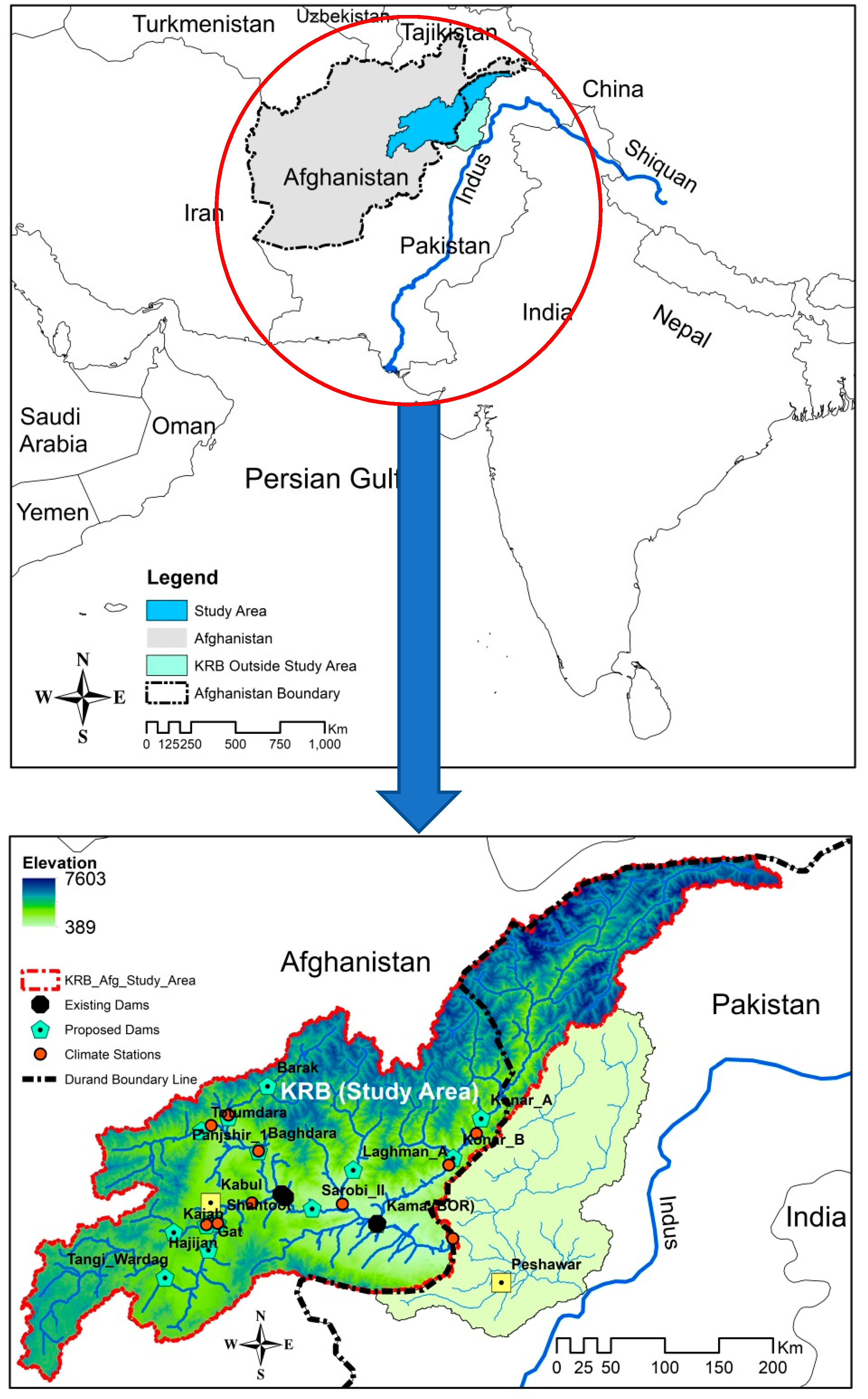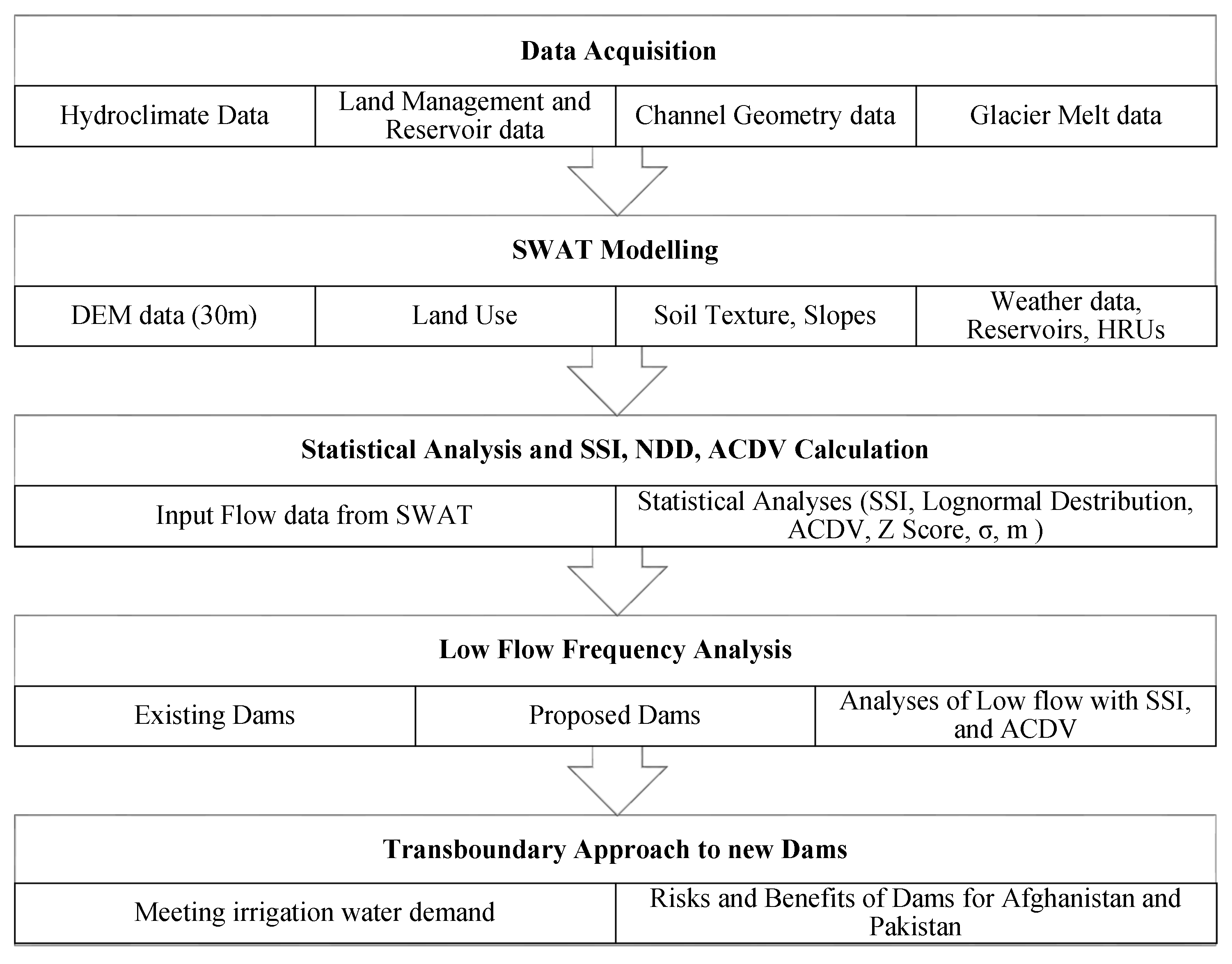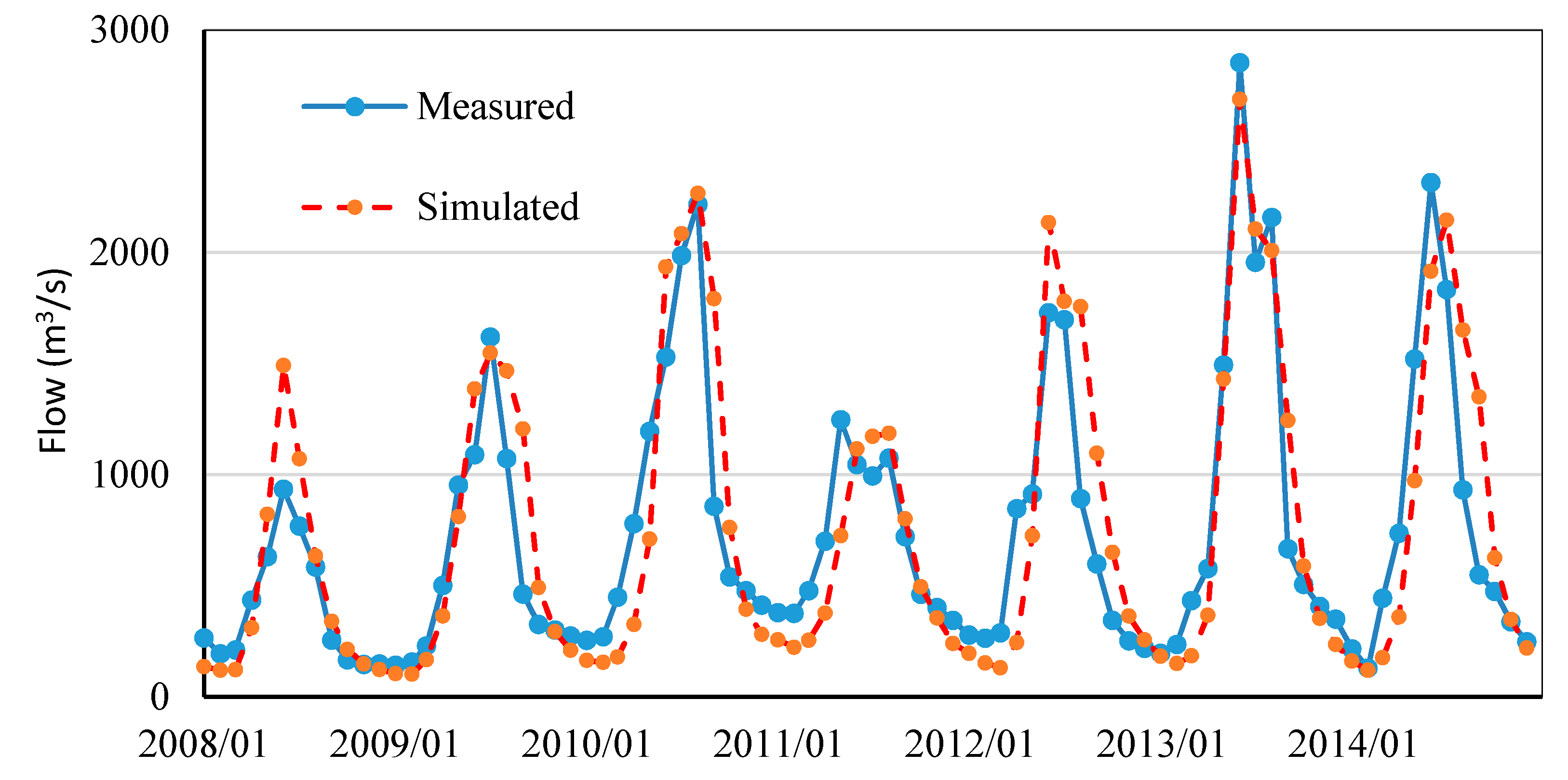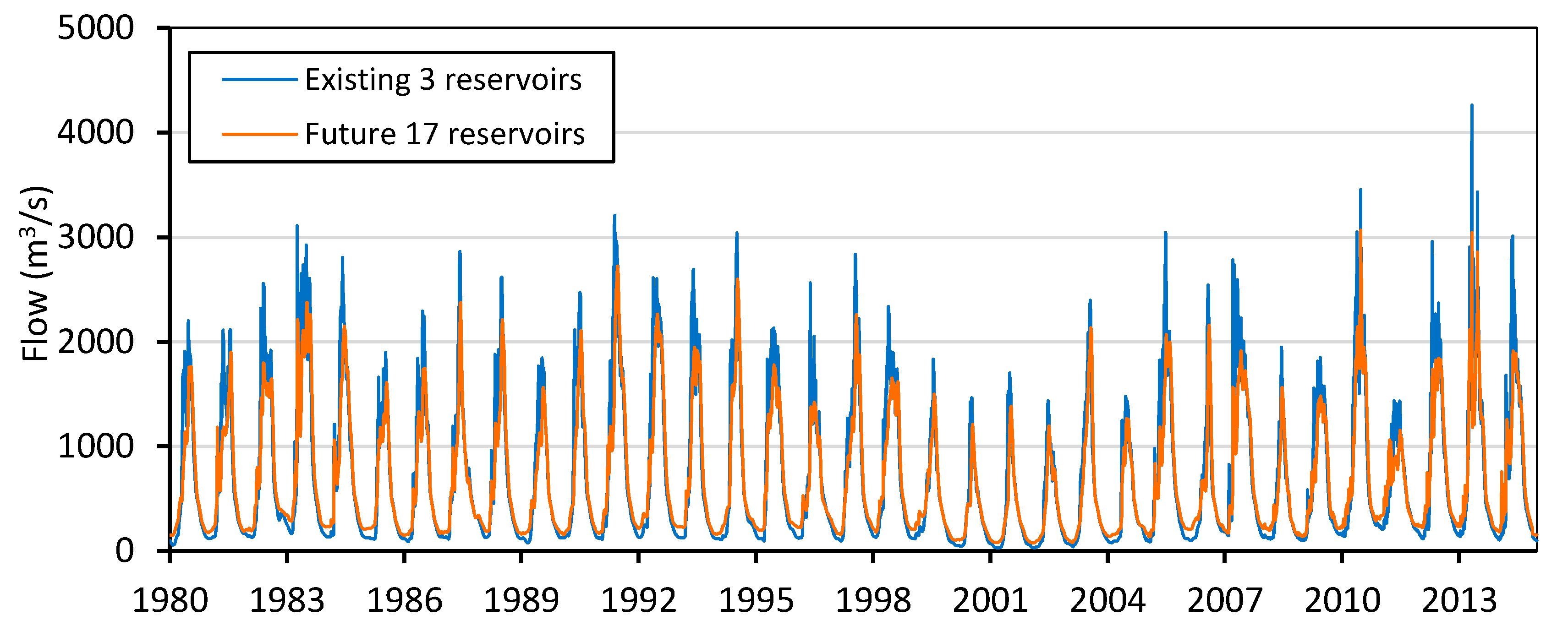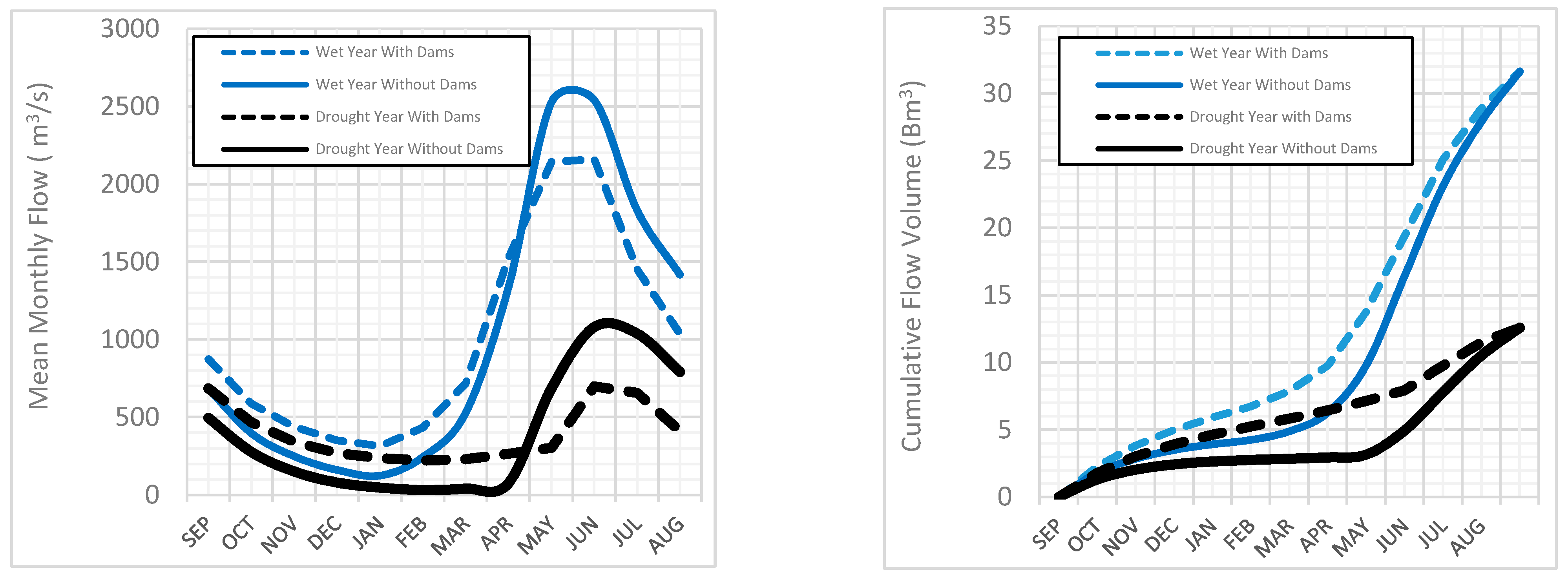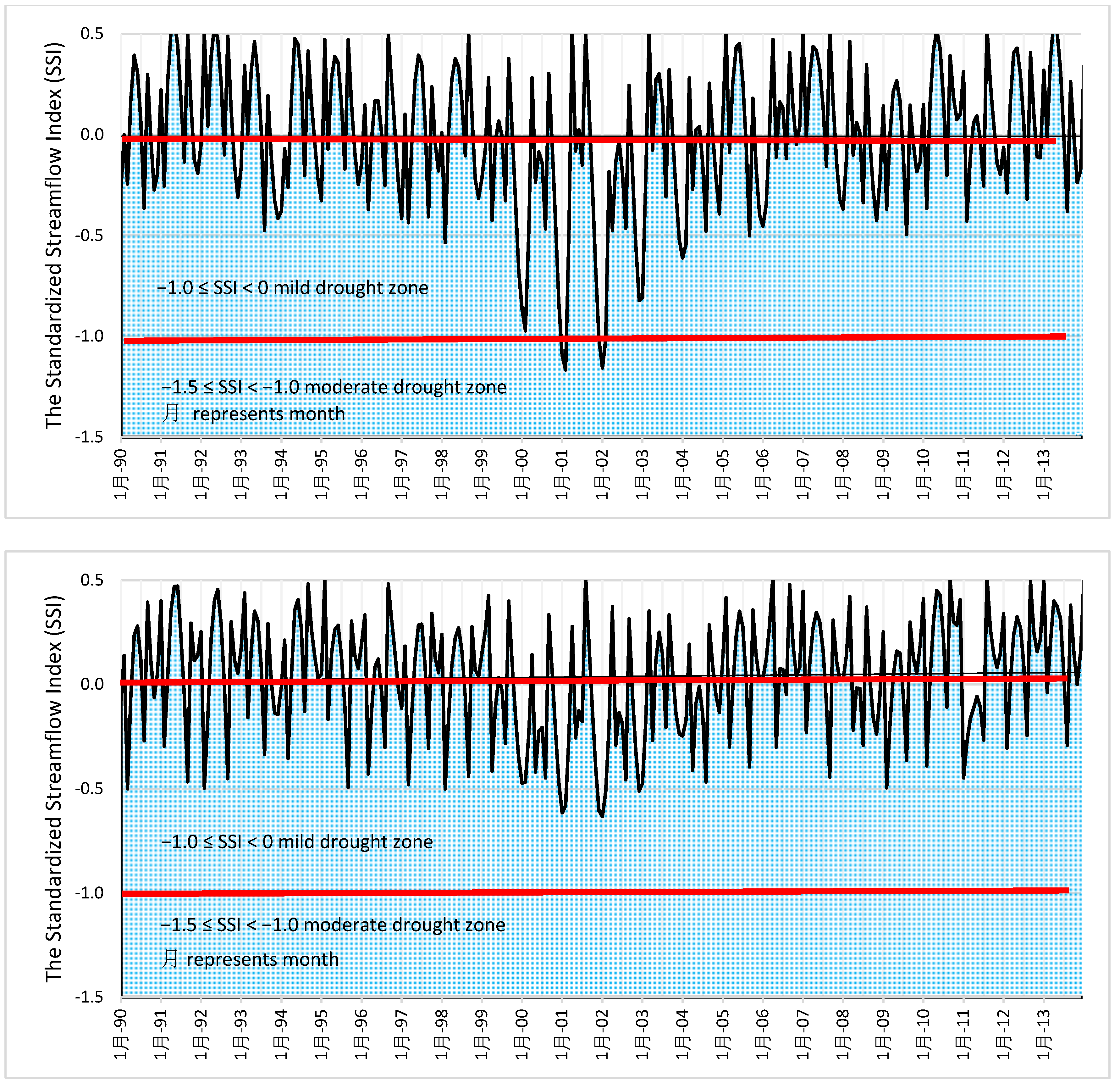2.1. Study Area
The KRB is located between longitude 67°40′ to 71°42′ E and latitude 33°33′ to 36°02′ N. The area of interest of the KRB in this study drains through the Dakah outlet into Pakistan, including ~53,150 km
2 of lands on the Afghanistan side [
13] and ~16,119 km
2 in the Konar-Pakistan area that drains into Afghanistan [
16]. The study area is distributed among five major catchment areas with distinct geographical features: the Logar-Upper Kabul sub-basin, Panjshir sub-basin, Lower Kabul sub-basin, Konar (Afghanistan) sub-basin, and Konar (Pakistan) sub-basin [
15,
20]. The Kabul River extends ~700 km from the origin to the Indus River junction. The Kabul River originates from the Sanglakh Range and flows eastward and runs through Kabul City and Jalalabad City before crossing the Durand Boundary Line (DBL) near the Laalpur Nangarhar Province, Afghanistan. The Kabul River crosses the DBL near the Dakah flow station in Afghanistan and then flows ~140 km further to the Indus River at Attock.
The KRB is the most populous sub-basin of Afghanistan and Pakistan’s most urbanized regions [
13]. There are six major cities in the KRB (Afghanistan) [
21], namely Kabul, Jalalabad, Charikar, Mehtarlam, Pule Alam, and Jabal Saraj, with a ~6 million population that benefits from the basin waters [
21]. There are also six major cities on the Pakistan side of the basin, with most of them being in the vicinity of the Kabul River and its main tributaries. There are three existing dams (Naghlu, Sarobi, and Darunta) in the study area of the KRB used for power generation, agriculture irrigation, and municipal water use (
Figure 1).
The KRB has a semi-arid and continental climate with elevations ranging from 300 m (ab. MSL) at the outlet to over 7000 m (ab. MSL) in the Hindukush Himalaya (HKH) Mountains, which are to the north of the KRB. The HKH Mountains are mostly covered with bare rocks, permanent snow, and glaciers above the altitude of 5000 m [
11]. Approximately 2.3% of the total KRB area is covered by glaciers [
1]. The average annual precipitation in the KRB ranges from 200 mm in the lower elevation to 3000 mm in the HKH mountains [
22,
23]. Regions of Peshawar, Nowshera, and Charsaddah in Pakistan are mainly irrigated with Kabul River water on 80.0%, 47.4%, and 84.7% of its total irrigated land, respectively [
14].
Over 80% of the area within Afghanistan is irrigated by river or rain, and the remainder is under groundwater-based irrigation [
24]. Afghanistan’s annual renewable water resources are 2019 m
3/capita on average [
24]. Hydrologic droughts, even for short periods, can have a dire impact on the population and livelihood. Climate change, including variations of precipitation and streamflow, is real and undeniable [
25,
26,
27,
28]. Since the agricultural lands are located in the mid and lower elevations, the effects of reductions in flow during hydrologic drought are substantial. Additionally, the flow is a major component of the hydrologic cycle. Hence, mitigation measures are needed urgently. The report provided by the World Bank (WB) in 2010 concluded that water storage sites are required to store excess water in the KRB depending on economic justifications. Some existing and proposed dams are listed in
Table 1 [
29].
The scope of strategic options for the development of KRB from the WB recommends seven storage projects with hydropower options, four storage projects without hydropower options, and two barrages on the Panjshir, Logar, Ghorband, Maidan, Kabul, Alingar, and Konar Rivers to meet the need for hydropower, urban water supply, and irrigation water demand [
29]. The locations of these WB proposed dams are shown in
Figure 1, as well as the three existing dams.
2.2. Methods
Ahmadi et al. (2019) described two groups of drought identification methods: (a) a probability and statistical calculation-based method, and (b) a threshold-based method (constant percentile of annual long-term cumulative frequency distribution and variable threshold). Both of the Ahmadi et al. methods require long time series of hydro-meteorological data. The variable method requires the daily quantiles calculation for the streamflow duration curve over the entire observation period [
30]. Another important aspect of drought identification and monitoring is the drought termination. The end of a drought is the critical time during which water resource managers urgently require information on the replenishment of supplies [
31]. Drought termination is associated with notable hydro-meteorological events, making the end of drought far more critical than the drought itself [
31]
The variable threshold considers the short-term drought identification and recovery, and the drought termination is looking at a specific timeline of a hydrologic events and are important knowledge for local managers and agricultural community.
This study is more focused on the longer hydrologic drought ignoring shorter events [
32] and is concentrated on the policy formulation and transboundary efforts in drought management during the entirety of this hydrologic event, including occurrence, termination, and recovery.
The basis for the technical evidence of this study involves the use of available spatial and temporal data for the KRB and utilization of the Soil and Water Assessment Tool (SWAT) model. The SWAT output flow data are used as inputs in the statistical calculation of the drought indices [
32].
Several methods to quantify the drought index have been developed employing the Z-score, where the Z-score is a statistical measure of interest herein as the Standardized Streamflow Index (SSI) based on the principles of “
Z” statistics and is directly related to any observed value,
x, the mean of the data population and standard deviation as:
where
Z is the standard
Z-score,
x is observed value, µ is the sample mean, and
σ is the sample standard deviation.
For a hydrologic period to be considered as drought, events are compared with truncation periods. To do so, they are compared with percentiles [
5,
33]. In statistical terms, there are benefits from the theory of runs that is a sequence of two or more types of numbers that symbolize the unbroken sequences.
The Standardized Streamflow Index (SSI) is a popular probability distribution function to determine the hydrologic drought by transforming the time series streamflow into a Gaussian distribution. In this study, the SSI and the annual cumulative deficit volume standardized by the mean flow (ACDV) [
33] are used to identify the patterns of drought events in the KRB and how the proposed dams will impact water shortages during droughts. The SSI parameter illustrates the streamflow water deficit concerning the standard deviation and long-term mean of flow samples at a specific location and specific time series [
33].
where
, if P ≤ 0.5,
, if P ≥ 0.5,
Additionally,
,
P is the function of lognormal distribution of flow data [
5,
34]
P is the probability of exceeding a determined Flow (Q) value,
µ and
σ are the mean and the standard deviation of the logarithmically transformed streamflow [
34].
Moreover, in Equation (2):
, , , ,,
‘Drought severity’ can provide insights to decide on the amount of water to be released to mitigate drought severity. For example, the 70th percentile of the streamflow will set a threshold where the flows under the 70th percentile are to be considered as part of a drought event [
33]
where
—Streamflow at selected thresholds (70%, 80%, 90%) at day i (the 70% threshold is used in this study)
—Daily flow at day (i = 1, 2, 3…)
—Mean annual flow at selected location.
The hydrologic drought is classified based on the SSI threshold. Any negative ranking of the SSI indicates a drought situation. The SSI drought classification is shown in
Table 2 [
35,
36].
One additional aspect is the effect of hydrologic droughts on peak flows. Vicente-Serrano et al. [
5] indicated that in basins with high seasonality, the hydrologic drought can also affect the streamflow during high flow periods, thereby impacting the water availability in reservoirs. This dimension is important for the KRB since it reflects the SSI for the entire basin, considering the spatial and time-specifics of the flow periods. The study results show how the proposed dams will address low flow intricacies and reduce the stress due to seasonal and annual hydrologic droughts.
Low frequency analysis is used to analyze the probability of water availability in a specific location under a specific threshold which can qualify the low flow as hydrologic drought [
37]. It provides information about the magnitude and frequency of flow discharges based on records of the lowest annual discharges collected at stream gages. In this study, the seven-day average for 2, 5, 10, 25, 50, and 100-year return periods were used as the 70th percentile threshold.
Different scientific communities are using different types of distributions for flood and low flow (drought) frequency analysis. Great Britain and China use the generalized extreme value distribution and the log-normal distribution, respectively, while other countries commonly use other distributions such as log-Pearson and Gumbel [
38]. Some popular distributions used to conduct frequency analyses are Generalized Extreme Value (GEV), Weibull (W2), Gamma (G2), Log-Normal with two parameters probability distribution functions (LN2), Weibull (W3), Gamma (G3), and Log-Normal with three parameters probability distribution functions (LN3).
Additional studies have evaluated the suitability of selecting distributional alternatives for flood frequency analysis, including [
39,
40,
41,
42,
43]. Given findings reported by the World Meteorological Organization (WMO) (1989) wherein a survey was conducted and concluded that log-normal distribution is one of the widely used distributions for flood frequency analysis [
44], this method was selected for flood frequency analyses in this study.
Based on the SWAT outputs, frequency analyses were conducted on low flows during the dry season. The SSI and ACDV were determined by employing outputs from SWAT. These findings were compared with flow outputs calculated for the post-reservoir scenarios to analyze the benefits of these dams on increasing low flow in downstream areas. Finally, mitigation measures to limit possible adverse effects of dams and limitations on water intake for irrigation are discussed.
Figure 2 shows the schematic approach of this study.
2.4. Data Acquisition and Processing
Weather data including precipitation, temperature, solar radiation, wind speed, and relative air moisture from 1979 to 2014 were obtained from the National Centers for Environmental Prediction (NCEP) Climate Forecast System Reanalysis (CFSR) for the KRB. CFSR collects global, high-resolution climate data, coupled with the atmosphere–ocean–land surface–sea–ice system [
49]. The measured data from ten flow stations in the KRB from 2007 to 2015 were organized for calibration, while the global weather data of the same period was also collected. Regression analyses between the simulated and available measured climate data showed an average coefficient of determination of 0.71 for precipitation and 0.76 for the temperature at the selected ten climate stations.
The GCM (General Circulation Models) dataset is recommended for climate change-related studies as per the United Nations Intergovernmental Panel on Climate Change (IPCC) Panel in its Fifth Assessment Report [
50]. These climate models were initially statistically downscaled using the Bias-Correction Spatial Disaggregation (BCSD) method, and gridded historical climate data by NASA Earth Exchange, NASA Ames Earth Center [
51]. The performance of NEX-NASA BCSD GCMs is useful for the basins of southeast Asia such as the Lower Mekong, China, India, Africa and many other countries/regions [
51,
52,
53]. Hence, high-accuracy projections of future climates are available for the KRB with the use of high-resolution GCMs, such as CANEM2 NEX CMIP5, CCSM4 NEX CMIP5, CNRM-CM5 NEX CMIP5, CSIRO-MK3-6-0 NEX CMIP5, GFDL-CM3 NEX CMIP5, and MRI-CGC M3 NEX CMIP5 Climate Projection. The datasets used in the study and their spatial and temporal resolution are shown in
Table 3.
The selection of a particular GCM climate model depends on a number of factors such calibration results between the baseline data and the simulated data, as well as the comparative analysis with other studies in a particular watershed. Examples of different studies which used different datasets for the same basin are: CCSM4, MIROL4, and BCC-CSM.1 by [
54]; BCC-CSM1 by [
55]; BCC-CSM1, CESM1-BGC, and BNU-GDDP (Global Daily Downscaling Projections) NEX_GDDP models by [
56]; GFDL and CanESM by [
57]. This study, enlightened from all prior recommendations and experience, used six datasets for analyses. Datasets of all six models were compared against the baseline datasets for the KRB. The analysis included the average increase or decrease in percentages of both precipitation and temperature. Analyses also included the seasonal change of the models with the baseline data and with the findings of similar climate change studies reported in prior works [
13,
18,
54,
55,
58,
59,
60,
61,
62,
63].
Datasets in this study employed the daily time-series historical data of six GCMs during 1990–2014 as historical data and data of future periods (2025–2049; 2050–2074; 2075–2099). Further analyses included the change in precipitation rates and temperatures based on both the year and season. Comparing the results of several climate models with some existing studies for the KRB, the climate data from the CCSM4 were identified to be more representative under the KRB conditions and hence were used to investigate the climate change impacts of flow regimes in the KRB.
To use SWAT for the KRB, geospatial data were obtained, including a 30 m resolution DEM (Digital Elevation Map), soil data, and land use data. Global Information System (GIS) data of stream network, basin boundary, location of climate, flow monitoring stations, and existing and potential dam sites were collected. In addition, the existing and future amounts of water used for irrigation and municipal supply in the KRB were estimated based on literature values. Additionally, the hydraulic and geometric features of future dams were determined based on the reports from the Ministry of Energy and Water of Afghanistan (MoEW) and the World Bank.
2.5. Existing and Future Irrigated Land and Its Water Demand
Over 80% of the KRB irrigated area is supplied by surface water resources. This study assumed the irrigated land expansion based on WB reports and past trends, where 20%, 30%, and 50% increases per quarter century of irrigated lands were considered in cases where new reservoirs are constructed. However, increases in irrigation areas may still happen even if proposed reservoirs are not constructed. This increase was assumed to be 50%, 30%, and 20% less than the assumed increase, respectively. This means that the agricultural land expansion will happen regardless, but with no storage sites the pace of expansion will be reduced.
There is a total of 292,680 ha of existing irrigated land in the KRB (Afghanistan) and ~59,330 ha of potential irrigated land that may be added to the current area of irrigation [
30]. The agricultural land expansion is an unpredicted process in most developing countries. Studies by Sidiqi [
56] and Najmuddin [
61] indicate an increase in agricultural land expansion beyond the predicted threshold in the KRB over the next 25 years. Since most studies predict that there will be up to 25% irrigated land area increases in KRB, in this study irrigated land areas in the model were increased by another 30% (compares to the 15–25% increase proposed by the WB) to account for unplanned agricultural land expansion, making it 77,129 ha. A similar trend was used in the Pakistan side of the KRB. After deducting the rain-fed and groundwater-fed irrigated lands, the potential and existing 337,309 ha of irrigated land will require an additional ~1100 Mm
3 of water from the KRB flows (
Table 3) in Afghanistan and Pakistan in addition to the currently utilized irrigation water of 4055 Mm
3. This constitutes 4% of the total mean annual average flow volume of the KRB flow. Existing and future irrigation water demands in the KRB (Afghanistan and Pakistan) are shown in
Table 4.
This study considered the increase in agricultural land beyond the official predictions as aforementioned. The potential future agricultural land irrigated from the Kabul River in Pakistan is calculated based on the total area of the Khyber Pakhtunkhwa province, total cultivated land in the province, and the land irrigated by surface water from the Kabul River as shown in (
Table 3) The total irrigated land increase is assumed to be 22% of the existing irrigated land in Pakistan. However, this KRB-related study is under the influence of various uncertainties related to precipitation, temperature variability, and other knowledge gaps in technical information, management practices, and political uncertainties that should be considered in future studies.
2.6. The SWAT Model of the KRB Flows
The SWAT model used in this study (also referred to as ‘the model’) considered only the KRB (Afghanistan) portion and Konar (Pakistan) with the joint outlet located at Dakah, Nangarhar. The model delineated the main river channels in the KRB, which resulted in 301 sub-basins. With a land-use area threshold value of 10%, soil area threshold value of 10%, and four slope classes (0–4%, 4–12%, 12–33%, and >33%), a total of 1949 Hydrologic Response Units (HRUs) were created for the model with an average HRU area of 39.5 km
2. Five elevation bands were created in each sub-basin based on the DEM to account for the variations of climate in the mountains. Water intakes in the model were assumed as per existing conditions and a future 14 reservoir conditions [
29].
Irrigation demand is high during April to August (12.7%, 17.1%, 25.1%, and 15.6% of annual water demand, respectively), followed by decreased demands from September to March (3.1%, 2.8%, 3.0%, 3.1%, 2.9%, and 5.3% of annual water demand, respectively) [
24]. This temporal distribution was used to calculate the irrigation water requirements for existing agricultural lands in the Afghanistan portion of the KRB [
10]. During the model setup, based on the available information, 80% of irrigation water was assumed from surface water (dams), while 20% was assumed from groundwater and precipitation.
Due to data limitations and the poor quality of available observed climate data in the KRB, additional data were needed. Hence, data from the Global Weather Data (GWD) including precipitation, temperature, solar radiation, wind speed, and relative air moisture from 1979 to 2014 were obtained from NCEP CFSR for the model calibration and reservoir assessment. Daily flow data from the Dakah station were used for comparison with the simulated daily flow.
